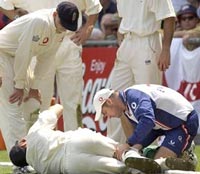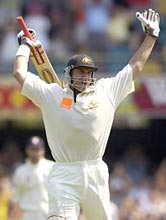Ashes begins on predicted lines
Daniel Laidlaw
At the toss, which signalled the commencement of the important part of
England's campaign to win back the Ashes for the first time in seven
attempts, Nasser Hussain had two objectives for his side: "Put it in the
right areas and take our catches."
In a contest that Hussain saw as a battle of fundamental skills rather than
psychological supremacy or anything of an abstract nature, that had to be
essential. England's original line was to remain in with a fighting chance
in the series by Christmas, the start of the fourth Test. That is to say,
they needed to start the series well, which they had failed to do in all
other recent campaigns bar 1997. With the emphasis they place on the first
session, the first day and the first Test, Australia had dominated from the
outset of all other recent meetings, which for England to be taken seriously
and, one suspects, retain faith in themselves, simply had to change.
All that made day one of the first Test just about the worst imaginable
start for England. Firstly, blame has to be attributed to Hussain for
electing to bowl. Whether defensive-minded in seeking to shield his batsmen
from the Australian attack or well-intentioned in the belief his bowlers
could make inroads, it was a mistake. Batting is England's strength, they
possess world-class openers, and the Gabba is an excellent wicket. So
Hussain immediately opened himself up to the second-guessing game.
 Secondly, the bowlers failed to accede to his simple plan and, when the ball
was placed in the right areas, three catches were put down, England's bane
last year. Worst of all, England, already derided for taking an
injury-plagued squad, suffered a terrible misfortune when their best bowler
of the day, promising young quick Simon Jones, slid awkwardly in the second
session and ruptured his anterior cruciate ligament. He needs a knee
reconstruction and is out for a minimum of six months. It was that bad.
Secondly, the bowlers failed to accede to his simple plan and, when the ball
was placed in the right areas, three catches were put down, England's bane
last year. Worst of all, England, already derided for taking an
injury-plagued squad, suffered a terrible misfortune when their best bowler
of the day, promising young quick Simon Jones, slid awkwardly in the second
session and ruptured his anterior cruciate ligament. He needs a knee
reconstruction and is out for a minimum of six months. It was that bad.
The challenge for the tourists now, after one day, is to regroup and
continue to fight, in the face of what is sure to a redoubling of negative
criticism and continued brilliance by their opponents. The problem, though,
is that it appears to have only taken one day to confirm what was expected,
that England are going to struggle dreadfully to manufacture 20 wickets. In
the tapes England were supposed to have reviewed, New Zealand, in two of
three Tests last season, only induced Australian middle-order collapses
after blazing 200+ starts by the openers. They aren't much of a blueprint
for applying pressure on the top order.
After New Zealand, Hayden and Langer did the same to South Africa, and it's
impossible to see what England possess to make them different or better.
Their bowlers lack the outstanding skill or a superior quality required to
make an impression: the pace of Shoaib Akhtar, wily spin of Shoaib, accuracy
of McGrath etc. England euphemistically refer to this deficiency as a lack
of "mystery", and it's been said they don't have a "mystery" bowler akin to
Murali, Warne and the like. There's nothing mysterious about quality,
however. Jones could have had it and Harmison might, chiefly because of
their pace. As for the rest...
Hoggard poses some threat because of his swing, but is not yet world-class.
Caddick, in Australia, is fairly straight-up-and-down. Giles, at best, can
tie down an end and White seems to only swing it into the right-hander. If
that's a negative slant, then it's largely a measure of how Hayden and
Ponting treated them.
Tellingly, most of the focus concerned what England needed to do to cause a
massive upset, but it was the Australian batsmen who came out seemingly
better prepared to play their game, doing so with an impressive degree of
poise and composure and -- mostly -- just the right balance between attack and
waiting to attack. Hayden and Ponting evidently hit the start of the series
in just the right frame of mind, for they appeared totally focussed yet with
a relaxed and confident execution. There was no excess energy expended, just
a cool demonstration of their class in a superlative batting exhibition.
 When Hayden did display moments of over-confidence or ill-judgement, he
received the benefit of luck either thanks to the initiative he and Ponting
commanded or an England mistake. Hooking Hoggard on 40, Hayden was caught by
Jones on the fine leg boundary, but the fielder had to dispose of the ball
before his momentum carried him over the rope, and the catch was annulled
(one would think having the facility to dispose of the ball is a clear
demonstration of control, but that is apparently the rule).
When Hayden did display moments of over-confidence or ill-judgement, he
received the benefit of luck either thanks to the initiative he and Ponting
commanded or an England mistake. Hooking Hoggard on 40, Hayden was caught by
Jones on the fine leg boundary, but the fielder had to dispose of the ball
before his momentum carried him over the rope, and the catch was annulled
(one would think having the facility to dispose of the ball is a clear
demonstration of control, but that is apparently the rule).
Losing some concentration after his hundred, Hayden sought to hit Caddick
over mid-off, Hoggard circled and twisted, but ultimately could barely lay a
hand on the ball. Later, Hayden miscued to deep cover striking White over
the top, and was horrendously dropped by Vaughan in his debut Ashes Test.
For veterans Hussain and Stewart, these blunders had to bring some bad
memories flooding back.
Ponting, sometimes, can appear susceptibly incongruous at No. 3 as he
over-balances towards the off side or lunges into his shots. Today, he was a
picture of balance and alertness, in tremendous touch as he scored his
fourth hundred in six Tests.
Winning the toss and inserting the opposition, England would have wanted at
least two wickets, in the first session. Instead, at huge expense, they got
two for the entire day, sustained a devastating injury and dropped catches.
In short, another Ashes series began according to expectations.
More Columns
Mail Daniel Laidlaw